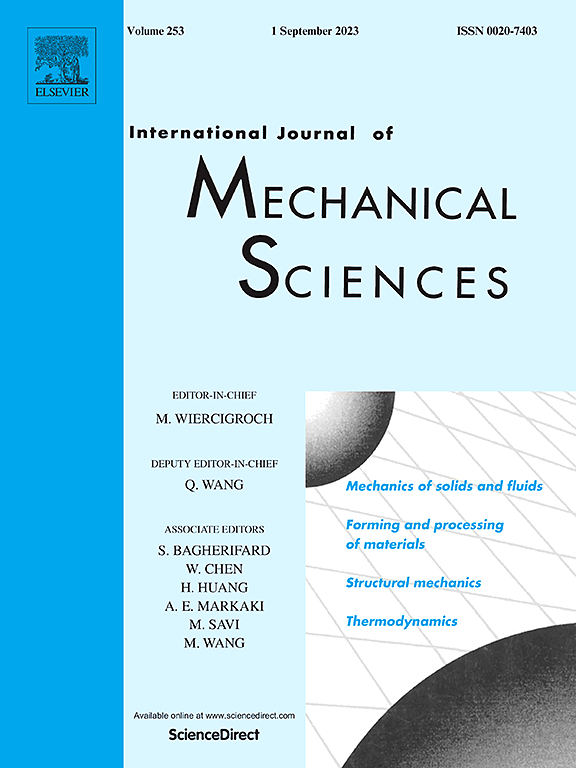非晶剪切带驱动的塑性:非均质性的作用
IF 7.1
1区 工程技术
Q1 ENGINEERING, MECHANICAL
International Journal of Mechanical Sciences
Pub Date : 2025-07-18
DOI:10.1016/j.ijmecsci.2025.110608
引用次数: 0
摘要
晶态材料中出现非晶态剪切带通常会导致脆性断裂。然而,在一些材料中,它被发现有相反的效果,作为塑性的驱动因素。最近的研究发现,这种剪切带塑性需要满足一定的必要条件,如非晶化过程中的密度变化较小(<6%),剪切带形成的能量低于解理。这项工作表明,在金属间化合物中,通过引入原子尺度的结构非均质性,可以大大提高剪切带塑性。具有非均质性的试样在5%左右的压缩工程应变下仍能发生塑性变形,而不具有非均质性的试样即使达到10%的压缩工程应变也不表现出明显的塑性。原子分析表明,软点和硬点的存在导致剪切带的渐进形成和离域,而不是突然的剪切局部化。这一发现为未来将这种塑性机理应用于开发高韧性新材料提供了潜在的解决方案。本文章由计算机程序翻译,如有差异,请以英文原文为准。
Plasticity Driven by Amorphous Shear Band: Role of Heterogeneity
The occurrence of amorphous shear bands in crystalline materials usually leads to brittle fracture. However, in some materials it was found to have the opposite effect, acting as a driver of plasticity. Recent research has found that this kind of shear-band plasticity should follow certain necessary conditions such as small density change (<6%) during amorphization and lower energy for shear-band formation than cleavage. This work demonstrates in an intermetallic that the shear-band plasticity can be greatly enhanced by introducing atomic-scale structural heterogeneity. The samples with such heterogeneity can be plastically deformed above a compressive engineering strain of about 5%, while the samples without the heterogeneity do not show significant plasticity even though the strain reaches 10%. Atomistic analysis reveals that the existence of soft and hard spots induces progressive formation and delocalization, rather than abrupt shear localization, of shear bands. This finding provides a potential solution to future application of such plasticity mechanism in developing new materials with high toughness.
求助全文
通过发布文献求助,成功后即可免费获取论文全文。
去求助
来源期刊

International Journal of Mechanical Sciences
工程技术-工程:机械
CiteScore
12.80
自引率
17.80%
发文量
769
审稿时长
19 days
期刊介绍:
The International Journal of Mechanical Sciences (IJMS) serves as a global platform for the publication and dissemination of original research that contributes to a deeper scientific understanding of the fundamental disciplines within mechanical, civil, and material engineering.
The primary focus of IJMS is to showcase innovative and ground-breaking work that utilizes analytical and computational modeling techniques, such as Finite Element Method (FEM), Boundary Element Method (BEM), and mesh-free methods, among others. These modeling methods are applied to diverse fields including rigid-body mechanics (e.g., dynamics, vibration, stability), structural mechanics, metal forming, advanced materials (e.g., metals, composites, cellular, smart) behavior and applications, impact mechanics, strain localization, and other nonlinear effects (e.g., large deflections, plasticity, fracture).
Additionally, IJMS covers the realms of fluid mechanics (both external and internal flows), tribology, thermodynamics, and materials processing. These subjects collectively form the core of the journal's content.
In summary, IJMS provides a prestigious platform for researchers to present their original contributions, shedding light on analytical and computational modeling methods in various areas of mechanical engineering, as well as exploring the behavior and application of advanced materials, fluid mechanics, thermodynamics, and materials processing.
 求助内容:
求助内容: 应助结果提醒方式:
应助结果提醒方式:


